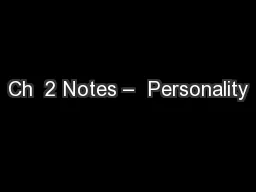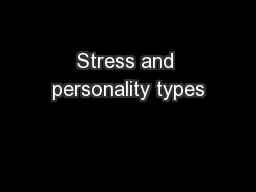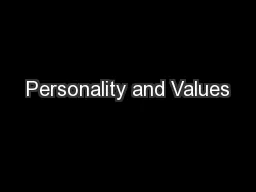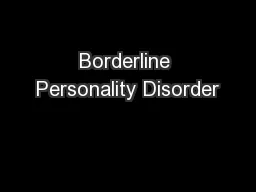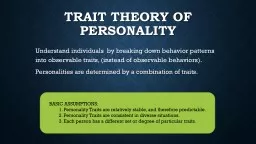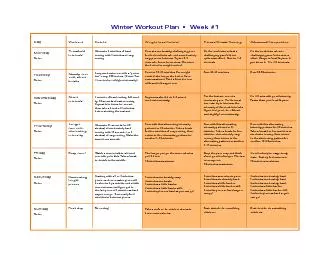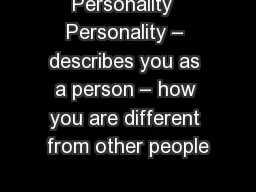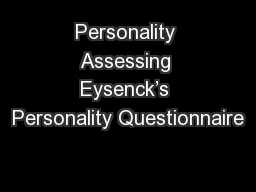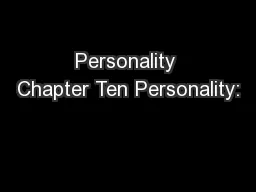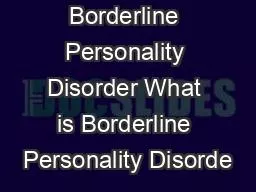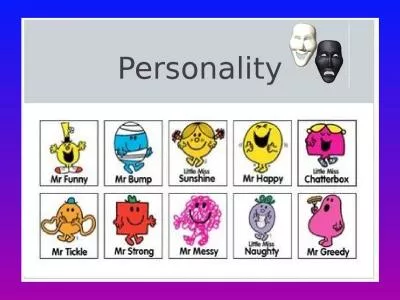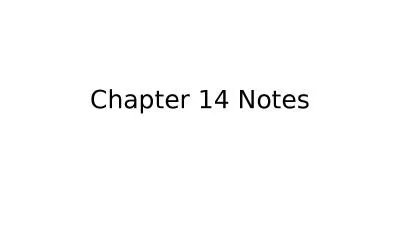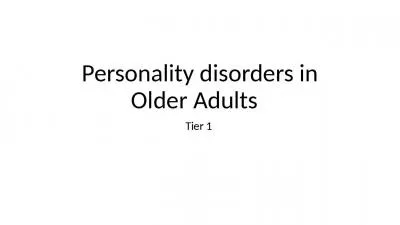PPT-Ch 2 Notes – Personality
Author : alida-meadow | Published Date : 2018-11-01
SelfEsteem and Emotions Section 21 Personality Describing Personality behaviors attitudes feelings amp ways thinking 5 central traits describe how people
Presentation Embed Code
Download Presentation
Download Presentation The PPT/PDF document "Ch 2 Notes – Personality" is the property of its rightful owner. Permission is granted to download and print the materials on this website for personal, non-commercial use only, and to display it on your personal computer provided you do not modify the materials and that you retain all copyright notices contained in the materials. By downloading content from our website, you accept the terms of this agreement.
Ch 2 Notes – Personality: Transcript
SelfEsteem and Emotions Section 21 Personality Describing Personality behaviors attitudes feelings amp ways thinking 5 central traits describe how people behave relate to others and react to change. A person does not n eed to have all of these symptoms to have the personality disorder What is the difference between OCPD and OCD People with OCD have insight meaning they are awar e that their unwanted thoughts are unreasonable People with OCPD th By Vinay, Anjali and Fowsiya. Definition. Type A personality: A type of personality which is characterized by constant time pressure, competitiveness in work and social situations and anger.. Hardy personality: provides defences against the negative effects of stress. This can be seen by having control over stressful situations and a mindset to meet challenges.. Personality and Values; . Are they related? . What is the framework on the association between the two? . Does Personality explain values or opposite? . What are values? . In general, values are important and enduring beliefs or ideals shared by the members of a culture about what is good or desirable and what is not. Values exert major influence on the behaviour of an individual and serve as broad guidelines in all situations. . Pia. Torres and Kristine Tran. Period 5. Vignette. Diana Miller, 25, entered a long-term treatment unit of a psychiatric hospital after a serious suicide attempt. Diana had been a sociable child until she turned 12. She became demanding sullen, rebellious, shifting from a giddy euphoria to tearfulness and depression. She became promiscuous, abused marijuana and hallucinogens and ran away at 15 with a boy. She craved excitement and would get drunk and dance wildly, and left with strange men. When she was 17, she made her first suicide attempt by cutting her wrist severely. She was obsessed with calories and with the need to have her food cut into particular shapes and arranged on her plate in a particular manner. If her parents didn’t do this she would have tantrums. She never had female friends and she has often been “eaten alive” with boredom. She languished at home, grew more depressed and agoraphobic and escalated her valium use. . Understand individuals by breaking down behavior patterns into observable traits, (instead of observable behaviors).. Personalities are determined by a combination of traits.. BASIC ASSUMPTIONS:. . Day Monday Notes: Tuesday Notes: Wednesday Notes: Thursday Notes: Friday Notes: Saturday Notes: Sunday Notes: Workout Intervals Steady row Repeat four times for one set then take a break of 3 minu Traits – the terms we use to describe yourself and others.. #1 - Social Cognitive Theory. Interaction of three factors. Cognitive-personal factors. • cognitive factors. • Include our beliefs, expectations, values, intentions, and. Hans Eysenck believed that we can describe people’s personalities by classifying them along two scales: . Introversion-extraversion scale. Stable-unstable . scale. The Big Five. Many contemporary trait theorists believe personality can be described using 5 traits:. Refers to an individual’s . unique and relatively consistent pattern of thinking, feeling, and . behaving. Personality . theory: . Describes . and . explains . how people are similar, how they are different, and why every individual is . National Instituteof Mental HealthWhat are the signs and symptoms People with borderline personality disorder may experience mood swings and may display uncertainty about how they see themselves and t Maladaptive variations or combinations of normal personality traits. Extremes on either end of specific trait dimensions can be associated with disorders.. An enduring pattern of experience and behavior that differs greatly from society’s expectations. %). In this section of the course, students explore major theories of how humans . develop enduring . patterns of behavior and personal characteristics that influence how . others relate . to them. The unit also addresses research methods used to assess personality. Case Study:. . You Are What Makes You Laugh. Section 1:. . The Trait Approach. Section 2:. . The Psychoanalytic Approach. Section 3:. . The Learning Approach. Section 4:. . The Humanistic and Sociocultural Approaches. Tier 1 . What is personality?. The . word ‘personality’ refers to the collection of characteristics or traits that we have developed as we have grown up and which make each of us an individual. These include the ways that we:.
Download Document
Here is the link to download the presentation.
"Ch 2 Notes – Personality"The content belongs to its owner. You may download and print it for personal use, without modification, and keep all copyright notices. By downloading, you agree to these terms.
Related Documents

